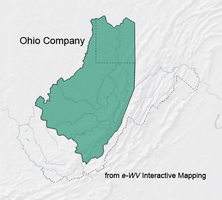
The Ohio Company was organized during the colonial period by a group of prominent Virginians, including Thomas Lee, Thomas Cresap, Augustine Washington, and George Fairfax. In 1747, the company petitioned the king for 500,000 acres to settle the frontier and for permission to trade with the Indians. The company was awarded 200,000 acres in Virginia’s northwestern corner. These lands were in present West Virginia and southwestern Pennsylvania. If the Ohio Company was successful in settling 200 families within seven years and if a fort was built for protection of the settlers, it could secure an additional 300,000 acres adjacent to the original grant.
The Ohio Company immediately came into conflict with both hostile Indians and the claims of other land companies which had patents for at least some of the same land. The French had not given up claims to the Ohio Valley and used their influence with Indian tribes to keep up raids on frontier settlements and to interfere with trade, further complicating the Ohio Company’s efforts to fulfill the terms of its contract. Nonetheless, the Ohio Company successfully maintained its existence through the French and Indian War and the American Revolution. However, conflicting claims from the Indiana and Vandalia companies, lengthy court battles, and the deaths of many of the company’s principal supporters led to its demise by 1792.
This Article was written by Kenneth R. Bailey
Last Revised on September 30, 2013
Sources
Bailey, Kenneth P. The Ohio Company of Virginia and the Westward Movement. Glendale, CA: Arthur H. Clark Co., 1939, Reprint, Wennawoods Pub., 2000.
Cite This Article
Bailey, Kenneth R. "Ohio Company." e-WV: The West Virginia Encyclopedia. 30 September 2013. Web. 26 July 2024.


Comments?
There aren't any comments for this article yet.
Click here to read and contribute to the discussion →